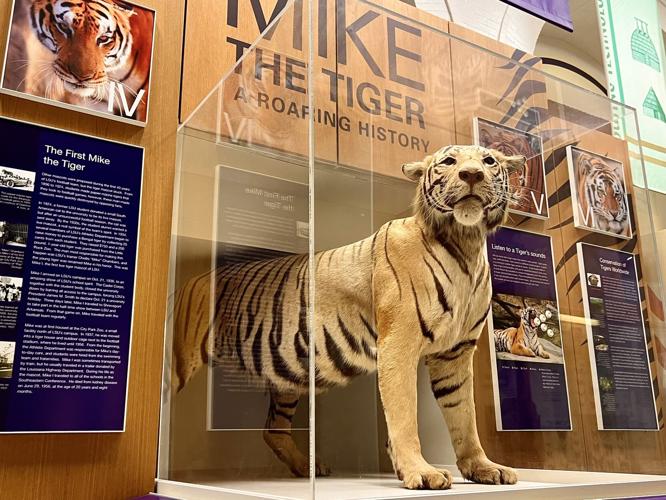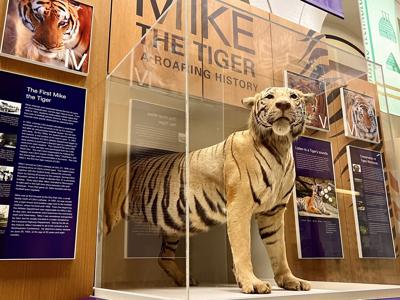Chances are, adults roaming the spaces between the LSU Museum of Natural Science's dioramas began making Mike roar when they were kids. That's as in Mike I, the first live tiger that served as LSU's mascot between 1936 and 1956. The Bengal cub originally was called Sheik at his birth in 1934.
A fundraising campaign was organized in 1935 when Athletic Department trainer Chellis “Mike” Chambers, athletic director T.P. Heard, swimming pool manager and intramural swimming coach William G. “Hickey” Higginbotham and LSU law student Ed Laborde decided to bring a real tiger to LSU, then known as the “Ole War Skule.”
A visitor to the LSU Museum of Natural Science presses the button to make Mike I roar. The taxidermy mounted pelt of LSU's first live mascot, Mike the Tiger, is the museum's most popular attraction. The deceased tiger's skull also is on display. Staff video by Robin Miller
They raised $750 by collecting 25 cents from each student, using the funds to purchase 1-year-old, 200-pound Sheik from the Little Rock Zoo in Arkansas.
He was renamed Mike in honor of Chambers. A photo of the trainer and Mike I is included in the exhibit where Mike I stands frozen in time, forever gazing into the distance while museum visitors stop to push the button that emits a tiger's roar.
But one recent visit to the museum prompted a thought for visitor Logan Smith, of Pollock. He and his wife, Megan, were visiting Baton Rouge when they decided to stop by the museum.
"My kids were pushing the button to make Mike roar, and I started wondering about the other deceased Mikes," Smith said. "Mike I is in the museum, but where are the others?"

The skull of Mike I, LSU's first live tiger mascot, is on display in the LSU Museum of Natural Science.
The answer is easy in some cases.
"Mike IV, Mike V and Mike VI were all cremated, and the urns containing their ashes are on display in the Andonie Museum on campus," Ginger Guttner, communications manager for the LSU School of Veterinary Medicine, said in September.
Guttner also is Mike the Tiger's daily voice on all of his social media accounts. She was Mike VI's voice until his demise in October 2016 and has been Mike VII's voice since his campus arrival in August 2017.
She backs up her answer by referencing the 2023 book, "Mike: The Tigers of LSU," written by the Mikes' former caretaker, David G. Baker. The three Mikes' ashes are on exhibit among other artifacts and memorabilia related to LSU athletics in the Jack and Priscilla Andonie Museum at the Lod Cook Alumni Center at 3828 W. Lakeshore Drive.

Wooden urns containing the remains of, from left, Mike IV, Mike VI and Mike V are on display in the Lod Cook Hotel on LSU's campus. The urns will be returned to their permanent home in the Jack and Priscilla Andonie Museum once the museum's renovation is complete.
Well, they're usually there. For now, the urns are on exhibit in a display case in the Lod Cook Hotel behind the Andonie Museum, which currently is closed for renovations.

Mike I, LSU's first live tiger mascot, came to the university in 1936. He died in 1956, and his taxidermy mounted pelt, along with his skull, are on exhibit in the LSU Museum of Natural Science.
Still, the hotel's display case is accessible to all visitors at its 3848 W. Lakeshore Drive address, just as the Museum of Natural Science is accessible from 8 a.m. to 4 p.m. Monday through Friday in Foster Hall on campus.
"Mike the Tiger is one of the most popular attractions in the LSU Museum of Natural Science, both among children and adults," said Irene Marti Gil, the museum's educational outreach coordinator. "Visitors engage with our interactive exhibit of Mike and often press the buttons to hear him roar."
The activity spans generations. Even today's availability of digital technology at the tap of a smartphone can't match the fun of pressing a button to produce a roar.

Mike II, LSU's second live tiger mascot, came to the university in 1956. According to , he was the second Mike II, the first having died after only a month at LSU. Mike II died in 1958, at Audubon Zoo. The whereabouts of his remains are unknown.
The roar is especially constant when school groups visit the museum, and kids visiting with their parents can't resist. Smith admits that he couldn't help taking a turn after his kids giggled at making Mike roar.
Mike IV came to campus on Aug. 29, 1976, and was retired to the Baton Rouge Zoo in 1990, where he died in 1995. Mike V arrived at LSU in February 1990 and died there on May 18, 2007. Mike VI, probably LSU's most popular live mascot, came to campus on Aug. 25, 2007, and was euthanized on Oct. 11, 2016, in hospice after a cancer diagnosis.
So concludes the easy part of the answer. Now comes the difficult part.
Where will you find the remains of Mike II and Mike III?
According to the Tiger Athletic Foundation-maintained website, , Mike II was born on Feb. 26, 1956, at Audubon Zoo in New Orleans. He secretly arrived on LSU's campus Sept. 28, 1958, and was introduced the next day, the opening day of football season.

Mike III came to LSU in 1958 just in time for the LSU football team's national championship season. He died in 1976. The whereabouts of his remains are unknown.
"Legend has it that less than a month after his arrival at LSU, Mike II died of pneumonia at only eight months of age," states. "Reportedly, Mike II was then secretly buried under a willow tree along the Mississippi River by newly appointed athletic director Jim Corbett, campus Police Chief C.R. 'Dick' Anderson and LSU Athletic Department business manager Jack Gilmore."
Which willow tree? And where exactly along the Mississippi River? Well, no one knows. But again, this is based on reports of the day.
Meanwhile, the website continues, to explain Mike’s absence, a statement was issued in the LSU Daily Reveille on Oct. 23, which said Mike was having trouble adjusting to his enclosure and was being kept inside “until he becomes more accustomed to the excitement of being a mascot.”

Mike IV, LSU's fourth live tiger mascot, came to the university in 1976 and died in 1995. The urn containing his cremated remains is on exhibit in the Andonie Sports Museum at LSU.
"Another cub of the right age was located at the Woodland Park Zoo in Seattle, according to Gilmore," the website said. "In addition to Gilmore’s testimony, several pieces of evidence support the legend that the original Mike II died and was replaced by another young tiger. Photographs of Mike II taken before and after his convalescence are clearly of two different tigers (facial markings of tigers are as unique as fingerprints), and he seemed to have grown at a tremendous rate. All rumors of the death and replacement of Mike II were denied."
The second Mike II reigned at LSU for only one season and died at Audubon Zoo on May 15, 1958, of complications associated with multiple fractures to his left rear leg. There are no reports as to how the leg was injured.
And there are no reports as to the whereabouts of this Mike's remains.

Mike V, LSU's fifth live tiger mascot, came to the university in 1990 and died in 2007. The urn containing his cremated remains is on exhibit in the Andonie Sports Museum at LSU.
Finally, there's Mike III. Before telling his story, it's probably best to jump to the end and reveal that the whereabouts of his remains are unknown.
Neither Baker's book nor pinpoint a resting place.
Mike III was born Nov. 26, 1957, at the Seattle Zoo and was introduced at the LSU vs. Hardin-Simmons game on Oct. 4, 1958, in time for LSU's 1958 national champion football year. After that, Mike III became a bigger celebrity than his predecessors as he made appearances at LSU's postseason bowl games.
"Because LSU competed in so many bowl games during the reign of Mike III, his caretakers have many stories to tell," . "Joel Samuels, known as the 'Tiger Man,' recalls an LSU-Alabama game when coach Bear Bryant was the Alabama head coach. Samuels had a way of getting Mike to growl simply by saying, 'Get 'em Mike.' As the Alabama players gathered around the tiger trailer, Samuels quietly gave Mike the signal to growl. When Mike did so, it so unnerved the Alabama players that Coach Bryant took Samuels aside and gave him a stern lecture, advising him in no uncertain terms that he was not to upset his players like that. As far as we know, none of the other tigers growled on verbal cue."

Mike VI, was probably the school's most popular tiger mascot. He came to the university in 2007 and was euthanized in 2016 after a stint in hospice due to a cancer diagnosis. The urn containing his cremated remains is on exhibit in the Andonie Sports Museum at LSU.
Mike III reigned 18 years as LSU's live mascot.
"During his lifetime, LSU won the national championship in football (with a 7-0 win over Clemson) and three SEC championships (in 1958, 1961, 1970)," states. "The football team played thirteen bowl games, winning eight of them and complied a 142-50-7 record overall. Mike III died of pneumonia on Thursday, Aug. 12, 1976, after the only losing season of his lifetime."
Though there's no known resting place for Mike III, you can still pay your respects to him in the National Science Museum, where the exhibit for Mike III pays tribute to all of the deceased Mikes with photos.
Leave your flowers for him there, and before leaving, don't forget to press that button to, as stated by that famous verse in "Hey Fightin' Tigers," "Make Mike the Tiger stand right up and roar — ROAR!"











